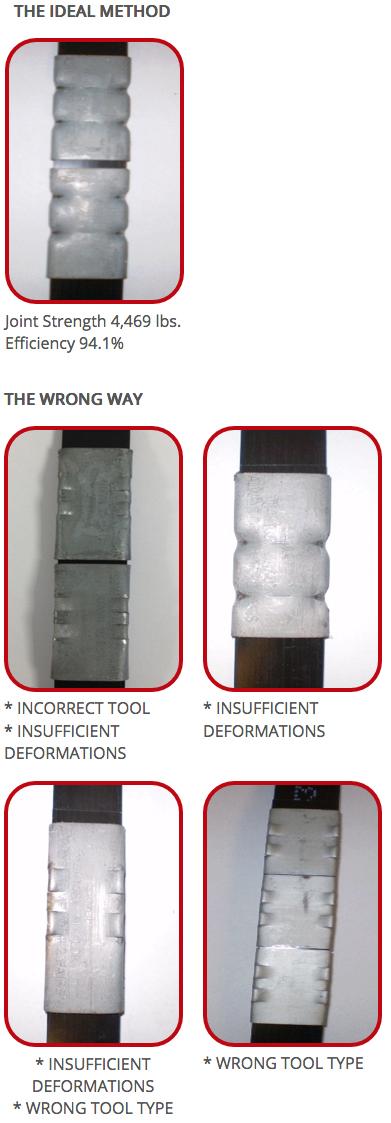It has been noticed that many freight loaders are improperly using their 1 ¼” steel strapping tools and seals, which after strapped, do not comply with the Association of American Railroads (AAR) rules. Tools are often not properly matched with the seal and application (i.e. a crimp seal being notched and vice versa), which can cause an unsafe working environment, as well as, worn tools.
The AAR Section 17.5.2 states:
Notch-type joints may be used only for packaging, unitizing, interlacing, layer, or encircling band applications and may not be used to secure loads to the car or on bands encircling the entire load of a floating load design.
Unless otherwise specified, applicable crimp-type joints may be used for all seal-joint banding applications for open top loading.
Examples of joint types include:
Seal Spacing
When dealing with seal spacing, notch or crimp pairs may not be any closer than ¾” on the same seal, or closer to ¼” to the end of the seal. Adequate spacing between the pairs and at the end of the seal is essential to a strong joint.
In all cases the number of notch or crimp pairs used on a single seal shall be limited based on the length of the seal. See Table’s 17.2 and 17.4 for notch and crimp limits by seal and length.
Application
1 ¼” x 0.029 HT P/W Strapping
- AAR Approved
- Break Strength – 5,450 lbs.
- Ductility – 5 bends minimum
- % Elongation – 5-12% of Six Inches
- Gauge: 0.029 +/- 0.002 in.
- Width: 1.250 +/- 0.005 in
- Paint: Electrodeposition (0.1 mil)
The IDEAL METHOD vs. the WRONG WAY:
Recommendations
When strapping an encircling load, it is recommended to use a pneumatic tool. This offers the most efficient sealing method when used in combination with the recommended operating PSI, as well as applying the seal near the top of the load.
Two additional rules of thumb are to ensure testing of seal joints a required practice and using the right tools for the right application. These same tools should be inspected and tested on a regular basis.
AAR Sections 17.7.2, 17.8.1, and 17.8.11 state:
(17.7.2) It is the responsibility of the user to ensure that the tools being used for tensioning and sealing are compatible with the type of banding and seals being applied, and are in good working condition and capable of producing a properly formed joint.
(17.8.1) Testing shall be performed by either the band or tool manufacturer, the AAR, or other certified testing facilities. The latter may use a user’s own test equipment, provided all required test functions can be achieved and evidence of industry-recognized certification of test equipment can be readily produced upon request.
(17.8.11) Users must maintain documentation of all test results for the most recent 24-month period. Current test records of each individually identified tool are to be maintained and made available for inspection upon request.
For additional strapping safety and training, contact Industrial Finishes by phone, 800.531.1305, or email info@industrialfinishes.com.
*Information in this post provided in part by Samuel Strapping Systems.













